I. What is Gluconeogenesis?
If you’re already in the mindset of thinking that this is the reversal of glycolysis, you’re already on the right track! Just based on the individual components of its name, you’ll be right to think that in this process, we’re producing glucose from various intermediates.
While not exactly the reversal of glycolysis, as not all the glycolytic enzymes are used, the idea is still there! Our goal is to produce glucose to be utilized by the body, an important idea that we’ll hound on in another article!
Try to approach and review this article similar to how you might review the glycogenesis and glycogenolysis articles, as glycolysis and gluconeogenesis are great “side by side” topics to contrast one another!
II. Gluconeogenesis
This is a pathway article, so you already know what’s coming up! We’ll leave a brief overview of the pathway below. Also note, that we’ve only included the major enzyme involved in this process!
A. Gluconeogenesis Overview
Gluconeogenesis is the process by which noncarbohydrate intermediates enter into the pathway and generate a molecule of glucose!
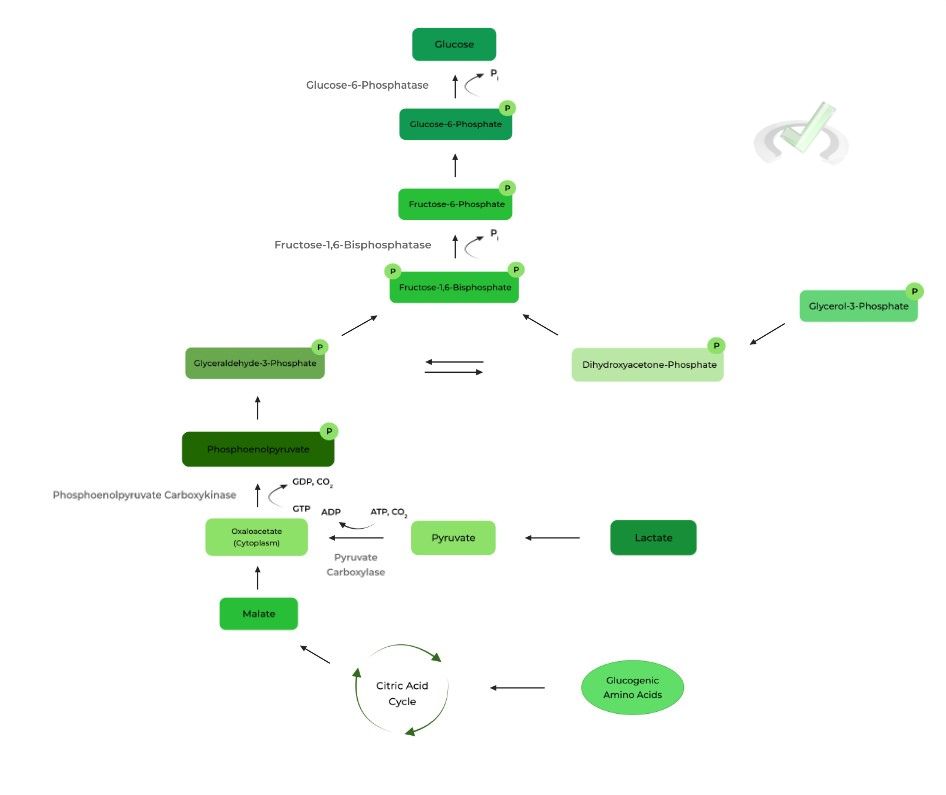
Note that when reviewing this pathway, you start from the bottom, specifically with pyruvate as the main starting point. We just illustrated it this way to mimic how glucose would eventually flow out of the cell.
B. Irreversible Enzymes/Steps
Similar to glycolysis, there are irreversible steps in gluconeogenesis which are subject to high allosteric regulation. These are the enzymes listed above as we’ll discuss more about their function below.
I. Pyruvate to Oxaloacetate (Pyruvate Carboxylase)
In this first step, a carboxyl group is added to pyruvate via pyruvate carboxylase to generate oxaloacetate. It may also help to count the carbons, as pyruvate is a 3 carbon molecule and the carboxyl addition generates a 4 carbon oxaloacetate.
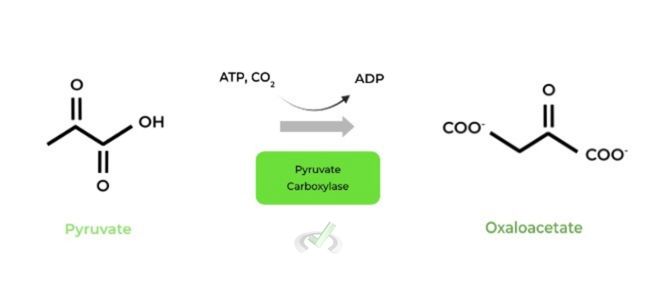
This step poses a problem as it occurs in the matrix and does not permit the exit of oxaloacetate from the mitochondria. To bypass this, oxaloacetate is first reduced to malate which can then exit into the cytoplasm.
Malate is then oxidized back to oxaloacetate in the cytoplasm which can then proceed with the gluconeogenic pathway.II. Oxaloacetate to Phosphoenolpyruvate (Phosphoenolpyruvate Carboxykinase)
This enzyme actually has dual function with the addition of a phosphate group and the removal of a carboxyl group in oxaloacetate, generating the phosphorylated 3 carbon PEP!
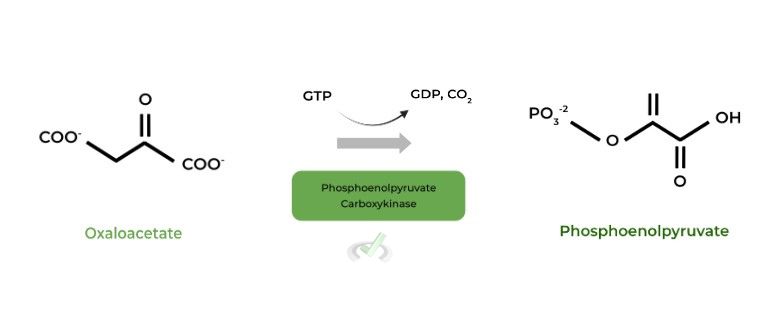
Additionally, it may be better to think of this step and the previous step as one combined, irreversible reaction!
This is because these 2 reactions oppose the action of pyruvate kinase. With these 2 reactions, we regenerated phosphoenolpyruvate and undo the substrate level phosphorylation that occured in glycolysis.III. Fructose-1-6-Bisphosphate to Fructose-6-Phosphate (Fructose-1,6-Bisphosphatase)
Essentially opposing PFK-1, this enzyme is also the rate limiting enzyme of gluconeogenesis as it removes the phosphate to generate fructose-6-phosphate.
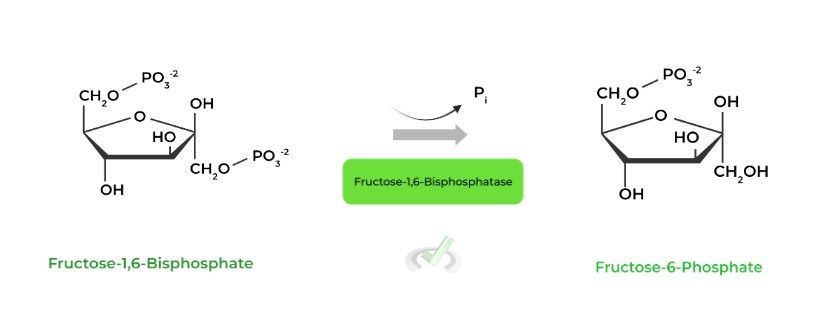
Try to think of the various hormonal regulators that might activate (or inhibit) this enzyme! We’ll cover them all in much more depth in another article, but just some food for thought if you haven’t gotten there yet!
IV. Glucose-6-Phosphate to Glucose (Glucose-6-Phosphatase)
In the last step, glucose-6-phosphatase also undos the action of hexokinase/glucokinase by dephosphorylating glucose-6-phosphate to generate a glucose molecule.
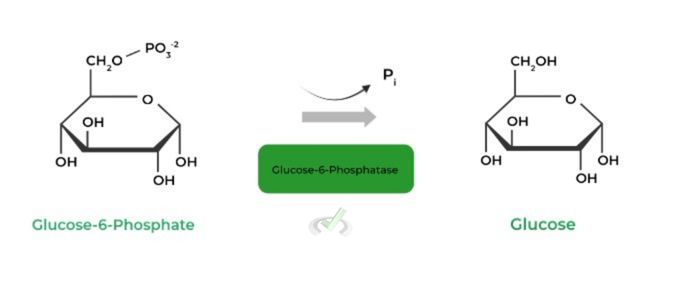
With the removed phosphate group, glucose is no longer charged and can use GLUT transporters to exit the cell and be utilized for the body, often to increase blood glucose and serve as an energy source!
C. Gluconeogenic Intermediates
The uniqueness about gluconeogenesis is that it can utilize noncarbohydrate substrates within the pathway to generate a glucose molecule! As displayed in the diagram, there are 3 main ones listed and further explained below:
I. Lactate
Recall this as the main product of lactate fermentation which occurs in anaerobic glycolytic conditions. This is relatively straightforward as lactate will be oxidized back into pyruvate.

This is actually an important concept for the Cori Cycle, where lactate build up from the muscle under anaerobic conditions (such as exercise) enters the bloodstream from the cell to travel to the liver hepatocytes.
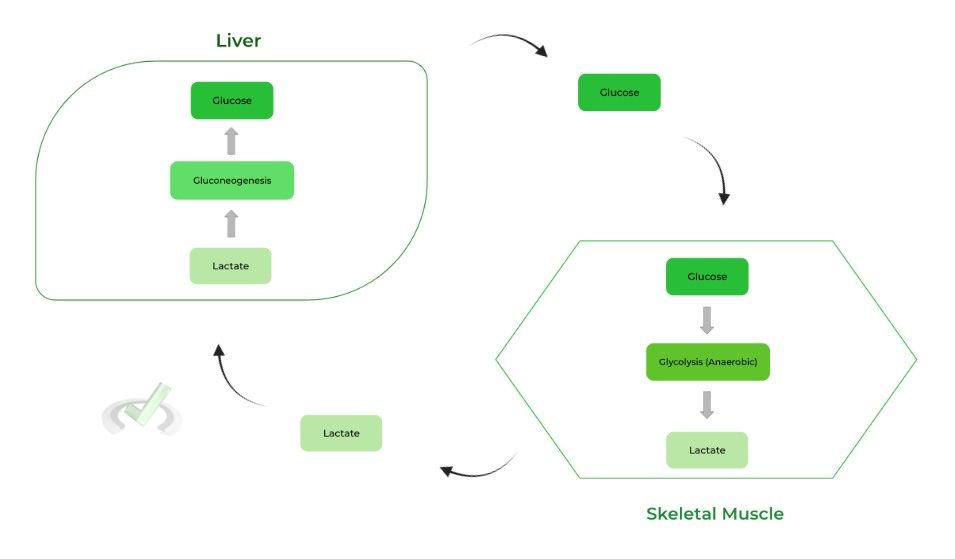
Here, lactate is utilized as a gluconeogenic intermediate to generate more glucose. This generated glucose can then enter the bloodstream and travel back to the muscle to be utilized in glycolysis and generate more energy.
II. Glycerol
You might recognize this molecule as the backbone for triglycerides! It turns out that glycerol can enter into the gluconeogenic pathway by first being phosphorylated to generate glycerol-3-phosphate.
The glycerol-3-phosphate can then be oxidized to dihydroxyacetone phosphate via glycerol-3-phosphate dehydrogenase, allowing for DHAP to enter into the pathway.
III. Gluconeogenic Amino Acids
These include all the amino acids with the exception of lysine and leucine! These amino acids primarily feed in through the citric acid cycle to eventually generate malate.
Recall that malate, not oxaloacetate, can exit the mitochondria: this is why the oxaloacetate produced via pyruvate carboxylase must first be reduced to malate and then is reoxidized back to oxaloacetate in the cytoplasm.

III. Bridge/Overlap
With so many enzymes, how can we keep track of all of them and their function? One tip we can give is to use the names of the enzymes to your advantage! This requires a solid foundation of enzyme classes, which we’ll review briefly!
I. Enzyme Name and Classification Review
We’ll briefly just overview the types of major enzymes utilized in gluconeogenesis: phosphatase, kinase, and carboxylase.
It’s best to cover kinases and phosphatases together as they oppose each other’s function. A kinase (classified as a transferase) catalyzes the transfer of a phosphate group of a nucleotide triphosphate to another molecule – in other words: phosphorylation.
A phosphatase (classified as a hydrolase) catalyzes the hydrolysis of a phosphate group attached to a molecule, thus releasing it – in other words: dephosphorylation.
A carboxylase (classified as a ligase) catalyzes the addition of a carboxyl group, originally in the form of carbon dioxide, to a molecule.
IV. Wrap Up/Key Terms
Let’s take this time to wrap up & concisely summarize what we covered above in the article!
A. Gluconeogenesis Overview
Gluconeogenesis describes the process where glucose can be generated from noncarbohydrate sources, including lactate, glycerol, and amino acids.
B. Irreversible Enzymes/Steps
Similar to glycolysis, gluconeogenesis also has various irreversible steps as listed below! A good thing to note is that these steps undo the actions of the irreversible steps in glycolysis!
I. Pyruvate to Oxaloacetate (Pyruvate Carboxylase)
A carboxyl group is added to pyruvate in order to generate oxaloacetate! However, because oxaloacetate cannot leave the mitochondria, it is first reduced to malate.
Malate can then exit the mitochondria and enter the cytoplasm and be reoxidized back to oxaloacetate to proceed with the pathway!
II. Oxaloacetate to Phosphoenolpyruvate (Phosphoenolpyruvate Carboxykinase)
A phosphate and carboxyl group are added and removed, respectively from oxaloacetate, in order to generate phosphoenolpyruvate.
It’s best to think of this and the previous step as one big reaction as they work together to undo the action of pyruvate kinase!III. Fructose-1,6-Bisphosphate to Fructose-6-Phosphate (Fructose-1,6-Bisphosphatase)
This step undos the action of phosphofructokinase-1 as it removes a phosphate group from fructose-1,6-bisphosphate, regenerating fructose-6-phosphate.
Likewise, it is also the rate limiting enzyme for gluconeogenesis and as a result is the site of much allosteric regulation!IV. Glucose-6-Phosphate to Glucose (Glucose-6-Phosphate)
Similarly, this enzyme undos the action of hexokinase/glucokinase, removing a phosphate group from glucose-6-phosphate to produce a new molecule of glucose.
The newly produced glucose molecule can then exit the cell via GLUT transporters in efforts to raise blood glucose and be utilized by other cells for energy!C. Gluconeogenic Intermediates
As stated above, gluconeogenesis allows for the production of glucose via noncarbohydrate sources, most notably lactate, glycerol, and glucogenic amino acids.
I. Lactate
Recall that lactate is produced during lactate fermentation under anaerobic glycolytic conditions. Lactate will simply be oxidized back to pyruvate which can enter the gluconeogenic pathway.
This is an important concept for the Cori Cycle, where lactate from the skeletal muscle is transported to the liver via the bloodstream and enters gluconeogenesis to produce glucose which can be used by the muscle again for energy!II. Glycerol
Usually after the breakdown of triglycerides, the glycerol backbone can be phosphorylated generating glycerol-3-phosphate.
The glycerol-3-phosphate can then be oxidized to dihydroxyacetone phosphate, which can then as well enter the gluconeogenic pathway.III. Glucogenic Amino Acids
Comprising all the amino acids except leucine and lysine, these amino acids usually enter into the citric acid cycle which can then produce malate.
Malate can then cross and enter it into the cytoplasm and be oxidized to oxaloacetate where it can continue gluconeogenesis!
V. Practice
Take a look at these practice questions to see and solidify your understanding!
Sample Practice Question 1:
In which of the following scenarios would you expect gluconeogenesis to be inhibited?
I. After Breakfast
II. During a Fast
III. During High Intensity Exercise
A. I only
B. III only
C. I and II
D. II and III
Ans. A
One way you can approach this problem is by answering the opposite question, when would gluconeogenesis be activated!
We’d expect gluconeogenesis to be active during a fast and high energy exercise because the body would need to produce glucose to increase blood sugar and provide a source of energy for the other cells of the body.
Sample Practice Question 2:
Which of the following enzymes would you expect to allosterically activate fructose-1,6-bisphosphatase?
I. Insulin
II. Cortisol
III. Glucagon
A. II only
B. III only
C. I and II
D. II and III
Ans. D
Recall that one common function of glucagon and cortisol is to increase blood glucose, one of the possible ways doing so being gluconeogenesis.
It makes sense that glucagon and cortisol are likely to allosterically activate fructose-1,6-bisphosphate as it’s the rate limiting enzyme of gluconeogenesis.







 To help you achieve your goal MCAT score, we take turns hosting these
To help you achieve your goal MCAT score, we take turns hosting these 





















 reviews on TrustPilot
reviews on TrustPilot